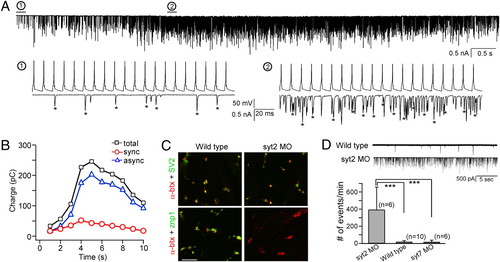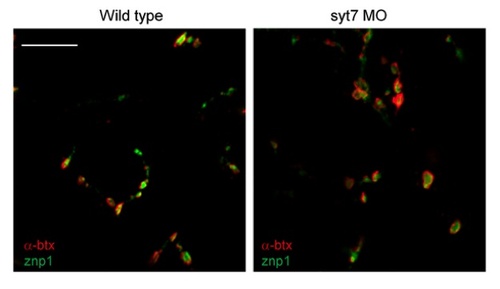- Title
-
Distinct roles for two synaptotagmin isoforms in synchronous and asynchronous transmitter release at zebrafish neuromuscular junction
- Authors
- Wen, H., Linhoff, M.W., McGinley, M.J., Li, G.L., Corson, G.M., Mandel, G., and Brehm, P.
- Source
- Full text @ Proc. Natl. Acad. Sci. USA
|
Effects of syt2 knockdown on release. (A) The 10-s train of EPCs in response to 100-Hz stimulation for a syt2 morpholino fish. Two regions are expanded on a fast time scale corresponding to times when, in wild-type fish, release is either largely synchronous (A1) or asynchronous (A2). Asterisks indicate EPCs considered to be synchronous. The increased frequency of synchronous events in A2 is likely due to the heightened probability that an asynchronous event will fall within the window defined for synchronous detection. (B) Comparison of the contributions of asynchronous (blue triangles) versus synchronous (red circles) to total release (black squares) over the time course of 10 s of stimulation. (C) SV2 presynaptic label (green) and postsynaptic α-bungarotoxin (α-btx) label (red) in wild type (Upper Left) and syt2 morpholino (Upper Right) fish. Znp-1 antibody labeled syt2 protein (green) colocalizes with α-btx (red) label in wild-type fish (Lower Left) but is absent in syt2 morpholino fish (Lower Right). (Scale bar, 10 μm.) (D) Example traces of spontaneous synaptic currents from wild type (Top) and syt2 morpholino (Bottom) fish. A bar graph of spontaneous event frequency for wild-type fish (392 ± 263; n = 6 recordings), syt2 morpholino fish (18 ± 14; n = 10 recordings), and syt7 morpholino fish (17 ± 21; n = 6 recordings). ***P < 0.001. EXPRESSION / LABELING:
PHENOTYPE:
|
|
Zebrafish syt7 gene and transcripts. (A) The location of exons on the gene (Upper) and transcript (Lower) are shown for zebrafish syt7. Exons are numbered on the basis of the mammalian gene (25, 26). The relative sizes of individual exons are indicated, along with the percentage identity to rat syt7 on the amino acid level (color indicators). The domains, predicted on the basis of homology to the mammalian gene are: transmembrane (black), calcium-binding C2 domains (dark gray), and alternatively spliced (light gray) regions. (B) RT-PCR analysis on wild-type and syt7 morpholino fish. The exon structures of the RT-PCR products and morpholino position are shown schematically. As a control the α-subunit of muscle acetycholine receptors was amplified from the same sample. (C) Syt7 antibody label (green) colocalizes with α-btx labeling (red) in wild type (Upper) but is absent at α-btx-labeled sites in syt7 morpholino fish (Lower). (Scale bar, 10 μm.) EXPRESSION / LABELING:
PHENOTYPE:
|
|
Znp1 presynaptic label of Syt2 protein (green) colocalizes with postsynaptic α-btx label (red) in both wild-type (Left) and syt7 morpholino (Right) fish. (Scale bar, 10 μm.) EXPRESSION / LABELING:
|



